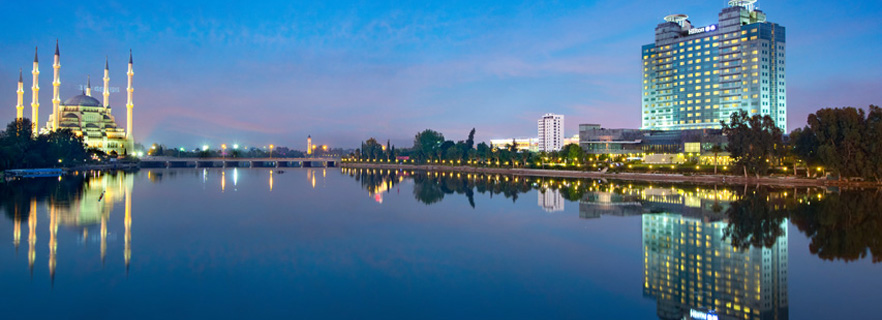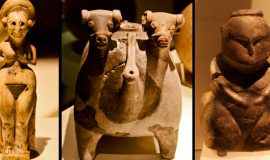 Adana
Adana
Turkey is the 5th largest city after Istanbul, Ankara, Izmir and Bursa. The city center is located on the Seyhan River within 30 km of the Mediterranean in southern Anatolia. It is the administrative center of Adana province.
The Adana-Mersin metropolitan area, which extends 100 kilometers from east to west, includes Mersin, Tarsus, Adana and Ceyhan cities with a population of 2.87 million. It is the fourth largest metropolitan area in Turkey and the leading trade and cultural center of the country.
The center of Adana; Mersin, Adana, Osmaniye and Hatay. It is located in the center of Çukurova which is a geographical, economic and cultural region. A large part of the region, which hosts about 5.62 million people, is a fairly convenient, large and flat area.
Etymology
According to many sources, the name Adana derives from the name of the city of Adana Uru of the Kizzuvatna kingdom under the Hittite Empire. Another claim is the name; The mythological Greek tribe that came from Egypt and settled in the Greek city of Argos is that of Danaoi or the legendary character Danaus. Early Egyptian texts linked to a country called Danaja are inscriptions from Thutmosis II (1437 BC) and Amenophis III (1390-1352 BC). After the collapse of the Mycenaean civilization (1200 BC) some of the refugees in the Aegean went to the Cilicia coast. Residents of Danayama or Danuna; It is defined as a group of sailors who attacked Egypt in 1191 BC during the reign of Ramesses III. [4] Denyan is known as the inhabitants of the city of Adana. It is also possible that there is a connection with demons living in da-nu (rivers) Dana-na-vo (Scythian immigrants) and Rigveda (Danavas) in the name PIE.
In the Iliad of Homeros the city is known as Adana. It was also known as Antiochia or Antiochia ad Sarum in Crikia during the Hellenistic period. The Helsinki Atlas editors temporarily defined Adana as Quwê (because it is mentioned in the nail script book). The name is also shown in some sources as Coa, and there are approaches that King Solomon, mentioned in the Bible, is the place to provide horses. The city is Armenian name Atana or Adana.
According to an ancient Greek-Roman legend, the name of the Adana name is; Adanus and Sarus, the two sons of Uranus who came one place near the Seyhan River (Sarus) and founded Adana. According to an older myth of the city's name, the name of Adad, the god of thunder, believed to live near the forest by the mythologies of Akad, Sumerian, Babylonian, Assyrian, and Hittite, and which is also known as Tesup or Ishkur, has been given to this region. The names and handwritings of the Hittites who proved this assertion were found in that area. This theory goes on to say that the God of the Thunderstorm brings too much rain and this rain is a bounty from the region to a great abundance. This god was loved and respected by the inhabitants of the place. In his honor, the region "Uru Adaniah"; In other words, "Adana Region" began to be referred to.
Adana's name has undergone many changes over the centuries: Adanos, Ta Adana, Uru Adaniya, Erdene, Edene, Ezene, Batana, Atana, Azana, Addane.
Geography
Adana is located on the northeastern side of the Mediterranean, which served as an entrance gate to Cukurova, more commonly known as Klikya, by westerners in history. This broad plain stretches along the southern part of the Taurus Mountains.
The road from Adana to Tarsus, west of Çukurova, passes through the hills in the foothills of the Taurus Mountains. The temperature drops with each elevation, because the road reaches approximately 4000 m of raki and passes through the rocky gate Gülek Boğazı and continues towards the Central Anatolian plains.
The hydroelectric power plant in the north of the city and the completed Seyhan reservoir in 1956 are surrounded. The dam is constructed for the gyroelectric strength and is intended to irrigate the low Cukurova plain. Two irrigation canals of the city pour into the ovens, traveling east-west along the city center. There is also another channel for watering the Yüreğir ovale.
Climate
Adana has a typical Mediterranean climate. The winters are warm and rainy; The summers are warm and hot. The highest temperature was measured on July 8, 1978 at 44.0 ° C. On January 30, 1980, the lowest temperature was recorded at -4.2 ° C.
History
The history of Adana dates back to 3,000 years ago; The archaeological finds in the region reveal the human settlements dating back to the Paleolithic Age. The Tepebag Tumulus, where the archaeologists found a stone wall and a city center, was built in the Neolithic Age and is considered to be the oldest city in the Cukurova region. A place called Adana is mentioned in the Gilgakish Epic, one of the Sumerian epics; But the geography of this work is too vague to determine the location of the mentioned place.
According to the Hittite Kava inscriptions in Hattusha (Boğazkale), Kizzuwatna was the first kingdom to rule Adana under the protection of the Hittites around 1335 BC. At the same time, the city was called Uru Adana and its inhabitants were called Danuna. The western influences of the Hittite Empire, which began in the years 1191-1189 BC, caused the control of the ovens to pass to numerous small kingdoms, followed by the Assyrians, 9th century BC; The Moroccans were Alexander the Great in 333 BC; Seleucids; Cilician pirates; Roman stateman Pompey; And the Armenian Kingdom of Cilicia (Kingdom of Cilicia) became a party in the control of the territory.
The history of Adana has a connection with the history of Tarsus in essence; These cities are often referred to as the same city, and their names have changed for centuries according to the seyrine, as the position of these two cities neighboring the Seyhan River was changed by the river. In the Romans period, Adana had a relatively low importance, and in those days Tarsus was in the metropolis of the region. During the Gnaeus Pompeius Magnus era, the city was used as a prison for the Cilicia pirates. A few centuries later, a local station was established on the Roman military road to the east of the city. After the definitive collapse of the Roman Empire in 395 AD, the region became part of the Byzantine Empire and probably developed during the reign of Julianus. With the construction of large bridges, roads, government buildings, irrigation and nurseries, it has become the most important and advanced trade center of the Adana and Cilicia region. Ayas (Yumurtalik in its present name) and Kozan (formerly Sis) were other major cities and administrative centers in the region, especially during the Cilicia period.
- Medieval
In the mid-7th century the city was taken over by the Arabs. According to a source of Arab origin, the name of the city comes from Ezene, the grandson of Yazene.
Byzantine took over Adana again in 964. In 1071, following the victory of Alp Arslan's Battle of Malazgirt, the Suljuks took control of a large part of the Byzantine Empire. They reached Adana a while ago and captured the city from 1071; And in 1097 the First Crusade was held in the hands of the city until Tenderred leader Tancred Adana was seized.
In 1132, it was captured by the Armenian kingdom of Cilicia under the command of Levon I. In 1137, the region was confiscated by the Byzantine forces, but the Armenians re-dominated the city around 1170. In 1268, a violent earthquake destroyed a large part of the city. After the earthquake, Adana was rebuilt and remained a part of the Armenian Kingdom of Cilicia until 1359, but after the end of a peace treaty city III. It was handed over to Mamluk Sultan of Egypt by Constantine. With the mamluks entering the city, many Turkish families were allowed to settle in Adana. Ramazanoğulları, brought by the Mamluks, is one of the Turkish families who ruled the city until the Ottoman Empire seized Adana.
- Recent history
After World War I, Adana and its environs were occupied by France. Mustafa Kemal Atatürk's diplomatic success during the War of Independence had to withdraw from France, Adana and its surroundings with the result of the Ankara Agreement dated 20 October 1921 (5 January 1922).
II. During World War II (January 30, 1943) British Prime Minister Winston Churchill and Ismet Inonu came together in Yenice, 23 kilometers from Adana. Meeting Churchill, Turkey's Allies II. He wanted to join the World War, but İnönü refused. In history this summit is known as the Adana Meeting.
In 1955, the NATO Air Base was established at Incirlik Bldg., 10 km east of Adana, in accordance with the agreement of the Democratic Party government with the United States. It was used effectively during the Cold War, the 1991 Gulf War and the 2003 Iraq War.
Chronology
The Roman Empire of Ancient Greece (333 BC), the Assyrian Empire (713-663 BC), the Persian Empire (550-333 BC), the Hellenic Kingdom of Greece (500-1333 BC), the Hittite Empire (1900-1200 BC) 323), Seleucid Empire (312-133 BC), Cilicia Principality (178-112), Romans (112-395 BC), Byzantine Empire (395-638, 964-1071), Abbasids, Great Seljuk Empire, Mamluks, Ramazanoglu Emirate , Ottoman Empire, Turkey.
Economy
Adana is one of the first industrialized cities and is now regarded as one of Turkey's economically developed cities. With the construction of the Seyhan Dam and the developments in agricultural techniques, major developments in agricultural productivity occurred in the 1950s. The big companies were built on the D-400 and Karataş roads. The service industry, especially banking, has developed in this process.
Adana; Is the marketing and distribution center of Cukurova agriculture area where cotton, wheat, soybean, barley, grapes and citrus fruits are produced in large quantities. Half of Turkey's corn and soybeans are produced in Adana. 34% of Turkey's landfill and 29% of orange are grown in Adana. Most farming and agriculture-based companies in the region have opened their general directorate in Adana.
Adana is an industrialized city based largely on agriculture. The textile and leather industry is the major industry branch that accounts for 29% of Adana's production and the number of plants producing vegetable oil processed food is also high. As of 2008, Adana is home to 11 of the top 500 industrial companies in Turkey. Temsa, the biggest company of Adana in the automotive industry, has more than 2,500 employees and produces 4,000 buses per year. Marsan-Adana is the biggest margarine and vegetable oil factory in Turkey. Advansa Sasa employs 2,650 people and is the largest polyester producer in Europe. The Adana Organized Industrial Zone is built on an area of 1,225 hectares and hosts 300 tesise, the majority of which are medium sized.
The city, which is a pioneering commercial center in the south of Turkey, contains regional offices of many public enterprises and joint stock companies. TÜYAP Fair and Congress Center hosts fairs, business conferences and is the main meeting point for the enterprises in Çukurova. The Cultural and Convention Center for 2000 people was opened to the campus of Çukurova University in 2010. The luxurious industry built on both sides of the Seyhan River and on the D-400 state road has also gained speed in the city. Hilton International, Seyhan and Sürmeli are 5 star hotels in the city. The construction of the Sheraton and the Turkmen Hotel is on the eastern side of the river.
The media in Adana is carried out through national and local agencies. New Adana, which was started to be published in 1918, is one of the oldest newspapers of Adana and is still in publishing life. Express, Taurus and Regional newspapers are both local newspapers in Adana and in Cukurova. Çukurova TV is the biggest publishing company in Adana. Kanala, Akdeniz TV and Kent TV are other major broadcasting companies. The regional publishing center of many national newspapers is located in Adana. The Hürriyet newspaper is the most popular regional newspaper with a circulation of 48,000 Hürriyet Çukurova.
Agriculture
The most productive oval of the country, which has been a center of attraction for many years due to the fertile soil brought by alluvium, is the sunflower, olive, maize, citrus (orange, citrus, mandarin and lemon), banana, kiwi, legumes, sugarcane, rice, soybean, cotton, grape , Pistachio, almond, watermelon, new world are produced in many products. Production is shifting from classical irrigation systems to sprinkler (drip irrigation) technology.
Transportation
Railway Station: Train Station; Ziyapaşa
The first railway line to Adana was established by the British in 1886. In addition to the diesel locomotive trenades between Adana and Mersin, there are also run-bus subway trains with the guide and dumu type accelerated suburban trains, making 27 trains each day between Adana and Mersin and the journey lasted for 45 minutes. As outline trains; İstanbul Haydarpaşa'ya Central Anatolia Blue Train; Çukurova Blue Train to Ankara, Erciyes Express to Kayseri and Euphrates Express to Elazığ.
Highway
It is possible to reach from Adana to Ankara, Mersin, Gaziantep and Hatay by motorway. D-400 Highway and international TEM highway reach to Adana. From Ankara to Aksaray, 472 km from Pozantı, 873 km from Izmir to Afyon-Konya-Ereğli, 909 km from Istanbul via Bolu, Ankara and Aksaray-Pozantı route. The distance to the city center is 5 km. There are bus services to all parts of Turkey from the bus terminal.
Airline
The city's air transportation has been provided by Şakirpaşa Airport since 1937. Adana Airport, where domestic and international flights are carried out, ranks 7th in the ranking of passenger transport in Turkey. Istanbul Atatürk and Sabiha Gökçen and Ankara-Esenboğa, İzmir, Antalya and Trabzon are the domestic airports; Direct flights to some cities of the Turkish Republic of Northern Cyprus (Nicosia) - Nicosia and Germany. The city is also located at Incirlik Airport, which is used as a military base.
Seaway
There are Botas Harbor and Toros Fertilizer Factory Ports open to international oil and freight transportation within the province of Adana.
In-city transportation
City transportation, Metropolitan Municipality Buses and private public buses, minibuses and taxis are used. Adana Metro, which has a 14 km route and 13 stations on it, was opened in 2010. Adana Metropolitan Municipality Buses, private public buses and light rail systems have been used since 2007. Kentkart smart ticket cards in Metro are used. Adana Metropolitan Municipality serves in a city with a network of 229 motorways.
Also you can do Cappadocia tours from Anada Incirlik Air Base
Cappadocia Tours from Adana Incirlik Air Base
Incirlik Air Base to Private Cappadocia Tour





 Adana
Adana











